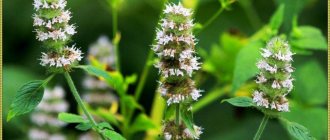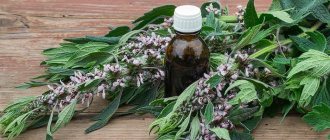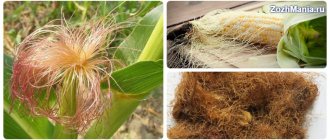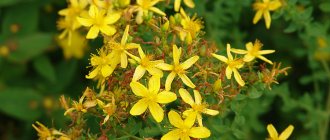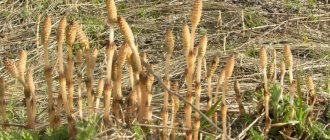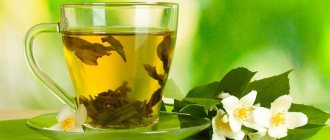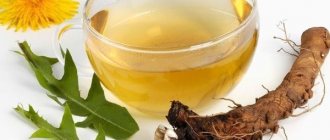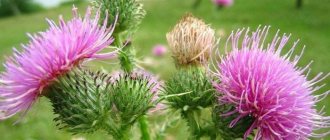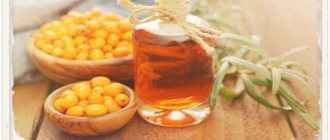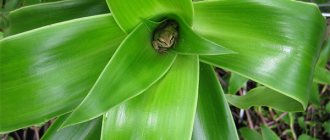The statistics are that more people die from overdoses or from counterfeit drugs than from car accidents. It is within our power to try to avoid this and use a forest pharmacy rather than a city pharmacy.
And lingonberry leaves are one of the main forest tablets with a pleasant sour taste.
All we have to do is collect them correctly, brew them and fill our body with the necessary vitamins and microelements.
Chemical composition
Lingonberries are considered almost a panacea for all diseases. But other parts of this plant also have the same properties. The leaves are indispensable in alternative medicine because they have a rich composition. Chemical analysis of plant materials revealed that it contains the following substances:
- phytoncides;
- arbutin;
- tannins;
- antioxidants;
- organic acids;
- B vitamins;
- routine;
- ascorbic acid;
- magnesium;
- zinc;
- manganese;
- iron.
Thanks to these substances, which are preserved during the drying process, lingonberry leaves have a beneficial effect on the human body. They do not lose their value even after long-term storage (up to 1 year).
Are there any contraindications?
The main thing is not to get carried away! You can drink in short courses for 7-10 days with a break of a month. You are at risk if you:
- Small child under 12 years old.
- They have already managed to develop an ulcer or hyperacid gastritis. Lingonberry leaves can cause increased gastric secretion, which will only increase pain.
- You have low blood pressure.
- The acidity is off the charts.
- Acute renal failure.
- Individual intolerance.
Collection and storage
There is an opinion that lingonberry leaves can be collected and dried at any time. But that's not true. To prepare raw materials, you need to choose the right moment, otherwise it will not be useful for use for therapeutic purposes. The fact is that during the growing season, when the berries form and ripen, the plant directs all its resources to them. Therefore, the active substances are not concentrated in the foliage. The optimal time to start harvesting is early spring, when flowering has not yet begun. After harvesting the berries, you can also prepare the leaves.
The most common collection option is cutting off small shoots, twigs with leaves. They need to be placed in a basket or box so as not to be damaged or crushed during transportation. If you use a bag or fabric bag for collection, you need to make sure that the leaves do not get wrinkled and do not compact them.
You can dry it in different ways. If you have an electric fruit dryer at home, you can load the plucked leaves onto pallets, turn on the low-temperature mode and get ready-made raw materials in 4-6 hours. You can spread out a clean diaper the old fashioned way and spread the collected leaves on it in a thin layer. Do not dry in the open sun - this will lead to the destruction of valuable vitamins and other active substances contained in the leaves. To preserve the benefits of plant materials for a long time, you need to pack them in a container with a lid and protect them from high humidity and temperature changes.
Harm to the body and contraindications
Lingonberries, the berries of which have beneficial properties and contraindications, are not used in the following cases:
- for gastritis with high acidity, stomach ulcers;
- for cholecystitis;
- if there is a history of hypotension;
- with urolithiasis.
Due to the diuretic properties of the fruits, they lead to the movement of stones in the kidneys and gall bladder, which will aggravate the pain and result in complications in the body. When the gastrointestinal mucosa is damaged (ulcers, gastritis), inflammation occurs, since lingonberry juice contains many organic acids. Fruit drinks and drinks can be consumed at any time, but preparations containing lingonberries can only be consumed before meals, on an empty stomach. This regime is important to bring real benefits to the body.
Lingonberries have the property of accumulating radioactive substances. Berries need to be collected in ecologically clean areas, away from enterprises and highways. Sometimes in swamps, berries “ring” from radiation, as rocket stages are dropped into remote, remote places.
Siberian berries are not as tasty as cherries, apricots or strawberries. Not everyone likes its tart taste. But the prepared desserts perfectly quench thirst, saturate the body with vitamins and give Siberian health and energy, which are so needed in our difficult environmental situation, which is combined with the fast pace of life.
Medicinal properties of lingonberry leaves
Lingonberry leaves are a real godsend for traditional medicine, because their properties are so numerous that they allow the raw material to be used for a wide variety of conditions and diseases. The influence of herbal remedies and their benefits differ for men and women.
For women
For women's health, lingonberry leaves are an indispensable remedy. It helps to quickly restore hormonal balance. Main medicinal properties that can be used for women:
- ability to stop bleeding;
- normalization of emotional state;
- effectiveness in diseases of the genitourinary system, adnexitis, cystitis, mastopathy.
The female body loses a huge amount of active components with the monthly onset of critical days. Lingonberry tea can make this period less painful and also help the body quickly recover from blood loss.
For men
Men's health can also be strengthened by using products based on lingonberry leaves. According to statistics, 55% of men over 40 years old have problems associated with the genitourinary system. Lingonberry leaves help restore health in case of urethritis, slow down the natural aging process, and prevent a number of dangerous diseases associated with loss of reproductive ability.
For prostatitis and infectious diseases of the urinary tract, the use of lingonberries can quickly relieve inflammation, eliminate discomfort and burning when urinating. Due to the general strengthening effect and antioxidants, this medicine protects against the development of malignant neoplasms in the organs and tissues of the reproductive system.
During pregnancy
Pregnant women in the first trimester are prohibited from using lingonberry leaves, as this can cause miscarriage. In the second and third trimester, they can be an alternative treatment for colds when strong pharmaceutical drugs are prohibited. Also, during pregnancy, periodic consumption of lingonberry tea helps to replenish the deficiency of minerals, folic acid, and iron. Lingonberry leaves prevent the development of anemia.
But you should not drink infusion and decoction from this plant often, because this can lead to low water intake. Lingonberry remedies have a pronounced diuretic effect, so you need to replenish fluid loss in time to avoid a dangerous condition.
Video:
what herbs destroy the fetus during pregnancy Expand
When breastfeeding
Breastfeeding is not a contraindication to the use of products based on lingonberry leaves. But there are limitations. The reception should not be too long. The use of alcohol tincture is also prohibited. The leaves are beneficial for nursing women and produce the following effects:
- help to quickly recover after childbirth;
- eliminate deficiency of minerals and vitamins;
- strengthen the health of the nervous system;
- prevent the development of pathological processes and congestion in the mammary glands.
In addition, if a nursing mother consumes products with lingonberry leaves, it is also beneficial for the child. It normalizes digestion, eliminates colic, and reduces gas formation. Children sleep better, suffer less from spasms and pain, and grow up calm.
For children
Even children over 6 years old can be given tea from lingonberry leaves. This herbal remedy can help you cope with colds faster and strengthen your immune system. In addition, the leaves are rich in organic acids and mineral compounds that enrich the brain. The plant helps to cope with high intellectual stress, improves memory and concentration, and stabilizes mental and mental development.
If you brew a small amount of lingonberries together with the leaves, this drink will improve your appetite and normalize sleep. But you cannot use it on a regular basis. If used too often, the child may become lethargic, as lingonberries slightly lower blood pressure.
When losing weight
In the fight against excess weight, a mild laxative effect can be used, as well as the diuretic effect of plant materials. This plant is also useful in that it can activate energy metabolism and stimulate the process of lipid breakdown in the subcutaneous tissue. If you are obese, you can use lingonberry leaves as an addition to your diet.
Lingonberry leaves clean blood vessels and improve blood microcirculation. The most common problem of all those losing weight is that there are very few blood vessels in adipose tissue, so the process becomes more complicated. But lingonberry leaves make blood circulate more actively and penetrate even the smallest capillaries, improving nutrition, as well as accelerating metabolic processes at the cellular level. Due to this, fat disappears faster even in the most problematic areas. But you shouldn’t count on results from lingonberry leaves alone. You need to reduce your daily caloric intake, move more and remember to drink at least 2 liters of water per day.
Reviews of the use of lingonberry leaves
Based on reviews, decoctions, infusions and teas made from lingonberry leaves rarely cause allergies or intolerances. More often than not, they are well accepted by the body, but the positive effect, like other natural drugs, does not occur immediately, but after a certain time has passed since the start of use.
It may seem that treatment with drugs based on lingonberry leaves is not as effective as pharmaceutical drugs, but this is only because their effect occurs gently and gradually.
Lingonberry leaves in folk medicine
Lingonberry and its leaves have been used in alternative medicine for centuries. During this time, folk experience was able to formulate the basic rules for use, and various treatment regimens for diseases were also developed. In order for the use of funds to bring maximum benefit, it is worth choosing the appropriate prescription and treatment regimen, according to the characteristics of the diagnosis that needs to be dealt with.
For diabetes
Endocrine diseases lead to imbalances throughout the body. Diabetes mellitus is a problem that medicine has not yet learned to overcome. The rate of development of pathology cannot be predicted, but the number of cases is increasing every year. Doctors are concerned that diabetes mellitus is “getting younger,” that is, pediatric patients with this diagnosis are becoming more common. But in folk medicine there are a lot of recipes that will help minimize the harm from diabetes. The most popular of them is the use of lingonberry leaves.
To normalize blood sugar levels, traditional medicine experts recommend drinking tea from this plant on an empty stomach. You should also include the berries themselves in your diet, but without sugar. You can drink a decoction of the plant in courses of 2 months, taking a break for the same period of time. To take courses, you need to prepare an infusion in a thermos from 1 tablespoon of raw materials and 400 ml of water. After 6 hours, strain the resulting product and divide it into 4 doses. Drink 100 ml morning and evening.
For pancreatitis
The chemical composition of the plant also has a beneficial effect on the inflamed pancreas. Due to its antibacterial and anti-inflammatory properties, it is possible to block attacks and exacerbations. Due to the antispasmodic effect, it is possible to relieve painful sensations. In addition, the plant reduces the rate of production of pancreatic enzymes, thereby reducing the irritant effect on organ tissue.
For diseases of the pancreas, the use of lingonberry remedies without a therapeutic diet has no effect. Gastroenterologists recommend fasting for the first three days, taking warm tea from the plant three times a day and drinking still mineral water. Further treatment should be accompanied by a strict diet (table No. 5) and regular consumption of a glass of decoction before each meal. The decoction should be prepared in a water bath. You can combine the leaves with crushed calamus root - 1 tablespoon per 600 ml of water. Brew and boil for 10 minutes, then stand, strain and take before meals for 3 weeks.
For gastritis
Tea made from lingonberry leaves without sugar is the first aid for stomach pain associated with gastritis. This plant relieves inflammation, normalizes the concentration of gastric juice, and protects the mucous membrane from damage. For chronic gastritis, regular use of tea is highly desirable, as it helps prevent the disease from progressing to a state where ulcers and cracks begin to appear.
In addition, you can use the following collection, which includes lingonberry leaves:
- 5 g coltsfoot;
- 2 g calendula;
- 5 g peppermint;
- 5 g chamomile.
You need to mix these herbs, add 1 liter of water and boil in a water bath for 30 minutes. You should get approximately 900 ml of the finished drug. You need to divide this volume into three days and take 100 ml three times a day, preferably after meals.
For gout
Lingonberry leaves contain 12 types of different organic acids. They successfully cope with uric acid salts, which lead to disruption of the functioning of the body due to gout. There are two popular treatment regimens that are used in acute conditions and in remission.
For acute conditions, you need to take 3 tablespoons of dry leaf and 300 ml of water. Pour water over the raw material and boil for 10 minutes. Wait for the broth to cool, strain it and drink 50 ml every 2 hours. In addition, you need to drink plenty of water, maybe with lemon - this will only speed up recovery.
For chronic conditions, you need to take 500 ml of boiling water per 2 tablespoons, but do not boil it - just brew it and let it sit. You should drink this infusion before meals. To make gout treatment progress more quickly, you can supplement your diet with juices from fresh berries and sour fruits. It is also recommended to enrich the diet with vegetables, herbs, grains, and minimize the consumption of salt and protein products of animal origin. It is worth eliminating sugar from your diet. You can add a small amount of honey to the infusion.
For the liver
The hepatoprotective effect of the leaves can be used to eliminate congestive processes in the liver, to reduce the toxicological effect of drugs during long-term treatment. The plant can be involved in the complex therapy of viral hepatitis, as it stimulates the immune response and protects cells from damage. You can drink the infusion of leaves separately or combine them into a collection. Here are three recipes for treating the liver.
- Grind the leaves into powder, mix in a 1:1 ratio with turmeric powder. Take ½ teaspoon 30 minutes before meals, three times a day. The course of such treatment is 1 month. Be sure to drink the powder with plenty of water.
- Take 20 g of crushed dandelion root, the same amount of lingonberry leaves, boil in a steam bath for 40 minutes in 500 ml of water. Let cool and strain. Drink 1 tablespoon before each meal.
- Grind the leaves into powder, mix in a 1:1 ratio with grated artichoke and milk thistle fruits. Eat 1 teaspoon before meals and wash down with warm, boiled water.
The liver can easily be treated with herbs, but you need to take care of it. During therapy, you should completely stop drinking alcohol and stop uncontrollably drinking painkillers and other chemicals. You also need to enrich your diet with raw vegetables and healthy fats - eat fish, use vegetable oils in small quantities for salad dressings, exclude vinegar, flour, and spicy foods.
Video:
beneficial properties and uses of lingonberry leaves Expand
For cystitis
Inflammation of the bladder is most often associated with decreased immunity, hypothermia and bacterial urinary tract infection. To relieve pain, you can use baths based on lingonberry leaves, calendula and chamomile. But you need to combine this procedure with taking a water infusion orally. The infusion should be drunk 5 times a day, warm, 150 ml. You need to prepare it from leaves (2 tablespoons) and boiling water (1 l). Brew the raw material in a jar, cover and wrap for an hour, and then strain.
If the temperature does not subside on the third day, you should not rely on herbal remedies. It is better to consult a doctor; you may need antibiotic therapy. Not all urinary tract infections respond equally to herbal treatment. In some cases, long-term pharmacotherapy is required to avoid complications.
For prostatitis
Prostatitis is one of the most common diseases in men over 45 years of age. It may not manifest itself for a long time, but when symptoms become obvious, the discomfort significantly reduces the quality of life. Moreover, prostatitis is also dangerous due to the severe complications that it can entail in the absence of adequate treatment.
Herbal medicine for prostatitis is needed as a supportive remedy, since the body takes a long time to recover. Lingonberry leaves are one of the most effective remedies that can be used in therapy. You can take infusion and tea twice a day. Tea - in the morning, and infusion - before bed. The latter contains a higher concentration of active components that eliminate inflammation. At night, the body recovers more actively, so you need to increase the dose in the evening.
But you can also combine lingonberry leaves with rowan and rosehip fruits and prepare a decoction. For 2 tablespoons of the mixture you need to take 600 ml of water. Boil for at least 15 minutes. When the liquid has cooled, strain through cheesecloth. Drink it 100 ml three times a day. The course of treatment can last from 10 days to 2 months, depending on the progress and initial condition.
For a cold
The antibacterial and antiviral properties of this plant are used for colds. In addition, lingonberry leaves have a pronounced ability to stimulate defense mechanisms, directing their resources to fight pathogenic microorganisms and other types of infections. To benefit from the application, you can use raw materials according to these rules.
- Brew the leaves of the plant with boiling water in the following proportions: 1 teaspoon per 300 ml of water. Leave for 5-10 minutes, and then drink in small sips with honey or raspberries, grated with sugar.
- A strong decoction of the leaves can be used as a gargle. To make the product more effective, you need to cool it to room temperature and add 1 teaspoon of vinegar per glass.
- You can use an infusion of the plant for inhalation for difficulty breathing, dry cough, or nasal congestion. You need to breathe over a bowl or pan with this infusion for 5 minutes.
After inhalation or taking the infusion orally, you should not go outside for 2 hours. This plant has a diaphoretic effect; if you go out into a draft or cold, you can catch an even worse cold. It is strictly forbidden to use inhalations for small children - they can get burned by the steam or turn over a container with hot liquid on themselves. Then severe burns will be added to the cold.
For varicose veins
A large amount of rutin and organic acids is what is needed for the successful treatment of venous diseases. To use the healing potential of the leaves, you need to take them orally, as well as prepare a decoction for compresses. It is better to apply compresses before going to bed. After the procedure, there is no need to overload your legs; it is advisable to give them the opportunity to rest by taking a horizontal position.
An infusion for the treatment of varicose veins is prepared from 20 g of raw materials and 600 ml of water. You need to steam the collection in a thermos, leave it and after cooling, drink 200 ml 3 times a day. Can be combined with other plants. Mix 100 ml of infusion with 2 tablespoons of fresh cabbage juice, add 5 ml of apple cider vinegar. Rub the resulting mixture onto areas of the skin where venous lesions are visible. Under no circumstances should this remedy be used for severe thrombosis, as this can lead to bleeding or blockage of the veins.
For mastopathy
An acute inflammatory process in the mammary glands can be accompanied by pain and fever. Lingonberry leaf has a complex effect on the body and allows you to relieve not only symptoms, but also inflammation. It can be used in two ways - externally and internally. It's better to combine them.
- Prepare an infusion of 10 g of leaves, brew 500 ml of water. Drink 1 glass 2-3 times a day.
- Apply compresses with a strong decoction externally. Boil 200 ml of water and 2 tablespoons of the mixture in a small container, cool and use for three daily compresses.
Mastopathy can lead to complications if left untreated or done incorrectly. Lingonberries help well in the initial stages, but if the process worsens, it is better to see a doctor. If there are no improvements after the first day of using folk remedies, there is no point in expecting them to happen later. The plant helps almost immediately, improves well-being and relieves pain.
For pyelonephritis
Inflammation of the kidneys in the acute stage requires the use of antibiotics, so you should not rely only on herbal medicine, this can result in dangerous complications. You need to combine them, especially since lingonberry leaves are not incompatible with antibiotics. For pyelonephritis, the use of alcohol is prohibited; any tinctures only overload the inflamed kidneys.
Treatment of pyelonephritis requires the use of a water infusion, which is prepared from a heaped teaspoon of leaves and 500 ml of water. To ensure that the leaves release all the active substances, it is advisable to brew them in a thermos. You can pour it in a saucepan, but cover it with a lid and wrap it up. Drink 100 ml infusion every 3-4 hours. In the treatment of pyelonephritis, you can use a collection of bearberry, coriander seeds and lingonberry leaves, mix a teaspoon of each type, pour a liter of boiling water and leave. Drink 100 ml every 2 hours.
For hypertension
Arterial hypertension is directly related to the health of blood vessels and kidneys. The advantage of lingonberry leaves is that they have a comprehensive effect on all systems, improving their functioning. You need to use an aqueous infusion of the plant twice a day, 150 ml, for at least 30 days. If attacks are not frequent, you can simply include lingonberries in your diet and drink tea from the leaves of this plant daily.
Use of lingonberry leaf
Lingonberry leaves have a fairly wide range of healing effects. They help in curing many ailments. In particular, herbal remedies based on them can relieve cystitis. Complex treatment not only shortens the duration of the disease, but also reduces its symptoms, thus alleviating the condition. If your doctor has prescribed antibiotics or other pharmacological agents, you should definitely consult about the use of lingonberry herbal remedies.
The effectiveness of lingonberry leaves for cystitis is based on the action of arbutin glucoside. In the human body, it is converted into a substance called hydroquinone, and then enters the genitourinary system along with the blood. The substance has a diuretic effect, so that the bladder fills and cleanses faster, and along with the fluid, pathogenic bacteria that cause inflammation are removed from it.
Interesting and useful: 10 easy ways to preserve lingonberries for the winter. It’s not for nothing that lingonberries are called the “berry of health.” It contains a lot of useful vitamins and microelements. If…
It is important to know that taking herbal remedies with lingonberry leaves can increase the pain syndrome, so this remedy is useful only during exacerbation of a chronic disease or with moderate severity of cystitis symptoms.
Lingonberry decoction for the treatment of cystitis is prepared from 1 full teaspoon of dried, crushed leaves, filled with 1 glass of water. Everything is brought to a boil and after 5 minutes removed from the heat. When the broth has cooled, it needs to be strained.
It is also good to drink lingonberry tea for medicinal purposes. It is brewed in the same way as a traditional drink, but instead of brewing, dried, crushed lingonberry leaves are taken in the same proportions. You can, as an option, buy a packaged drug at a pharmacy. True, the effect of tea will be less than that of a decoction.
We recommend watching the video: Medicinal properties and use of lingonberry leaves in folk medicine.
Types of healing compounds
Dried lingonberry leaves are the basis for the preparation of various medicines. To harness the therapeutic potential of this plant, you need to know the recipes. Below are the most common options for preparing medicines based on this plant.
Infusion
There are many different recipes for preparing an infusion, but each of them differs in the concentration of medicinal substances in the resulting product. An infusion is the easiest way to prepare homemade medicine. Three classic recipes are most often used.
- Pour 1 tablespoon of leaves into a thermos and pour 500 ml of boiling water. Leave the infusion for 4 hours, and then take 50 ml at a time.
- The easiest way to prepare it is to steam 2 tablespoons in 1 liter of boiling water. Leave covered for 30 minutes. After this, drink the infusion 150 ml at a time. You can store it in the refrigerator for no longer than 72 hours.
- Another option is to brew 2 tablespoons of raw material in 1 liter of boiling water and cover the container with the lid closed. The product should infuse for 2 hours, then you can use it for internal or external use.
The infusion is prepared for 2-3 days, no more. Despite the fact that it does not deteriorate, in its finished form, during longer storage, it loses some of the active components.
Tincture
The tincture should be prepared only from dried lingonberry leaves; fresh ones will not work. You can add a small amount of dry twigs to make the product more concentrated and aromatic. The cooking recipe consists of the following steps:
- Wash and dry the container with lid.
- Pour 1 tablespoon of chopped lingonberry leaves into the bottom of it.
- Pour in 250 ml of alcohol.
- Cover with a lid and keep in a dark room for at least 14 days.
The finished tincture must first be strained, and then used in doses according to the rules - 20-30 drops per dose, no more.
Decoction
A decoction of lingonberry leaves contains maximum benefits for the body, because during the preparation process it is possible to extract everything that is in it from plant materials. You can cook over low heat or in a water bath. There may be three concentration options:
- 2 tablespoons per 1 liter of water;
- 1 glass per 1 liter;
- 2 tablespoons per 500 ml.
A stronger decoction is used for external use. If you drink it, you need to reduce the volume for a single use by 2-3 times. A weak, not concentrated decoction is a product for oral administration, douching, and inhalation.
Tea
Tea made from lingonberry leaves is not just a medicinal remedy, but also a tasty, aromatic drink. It can be served with lingonberry jam, honey or sugar. This is the lightest dosage form, with a minimum amount of medicinal elements in the composition. But at the same time, it can be consumed daily without fear of overdose or side effects.
To prepare tea, you need to take a handful of dry leaves, brew in a container with a lid and leave for 5 minutes. After this, you can pour into cups and enjoy the aromatic medicine. It is better to prepare tea one at a time; it does not last long. The optimal ratio of raw materials and water is 1.5 teaspoons per 500 ml.
Instructions for preparing decoction, infusion and tea
to prepare medicinal drinks, you can use raw materials prepared independently or purchased at a pharmacy
Decoction
- Art. l. steam the raw materials with a glass of boiling water;
- keep on low heat for 30 minutes, strain;
- add water until the original volume is obtained.
Take 60 ml of lingonberry leaf decoction. up to 3 times a day before meals. Helps cope with sore throat and inflammation of the urinary system.
Infusion
- combine tsp. dry raw materials and a glass of boiling water;
- leave for an hour;
- strain and drink 1/2 cup up to 4 times a day.
An infusion of lingonberry leaves helps cope with rheumatism and gout, and is effective in the treatment of chronic gastritis and diarrhea, and urological pathologies.
Lingonberry tea will help restore strength after heavy physical and mental stress, calm the nervous system, and normalize emotional balance.
Tea
You can brew lingonberry leaves according to the following recipe:
- take fresh leaves in the amount of tsp;
- pour 200 ml. boiling water, leave for half an hour;
- strain and drink in three doses per day.
Lingonberry tea vitaminizes the body, is a preventative against colds, and helps with poor digestion, chronic fatigue and stress.
Tea not only quenches thirst, but also strengthens physical and mental well-being and lowers blood pressure.
Application in cosmetology
Since ancient times, lingonberries have served as one of the main components for the preparation of cosmetics. It is used for various problems with appearance. The plant helps eliminate oily hair, making it silky, thick and manageable. It can also be used for skin beauty.
- Hair balm: 20 g of collection, 0.5 liters of water and 2 tablespoons of lemon juice. Rinse your hair after shampoo and do not rinse.
- If pimples and blackheads often appear on your face, you need to prepare an infusion - 30 g of herbs, brew 400 ml of boiling water. Store the liquid in the refrigerator, wipe the skin morning and evening before applying moisturizer.
- If there are bags and dark circles under the eyes, you need to soak cotton pads in the broth and apply to the eyelids for 30 minutes. The effect will be noticeable almost immediately, but regular use is required for long-term results.
- A mixture of fresh lingonberry juice and lingonberry leaves will help you quickly get rid of freckles and age spots. Rub the finished mixture into problem areas and leave for 5-10 minutes, and then rinse off.
- Lingonberry infusion can be used as a means of rejuvenation. You need to freeze it in an ice tray and use it as a tonic and tightening agent. You can wipe your face with this ice only if there are no inflammations or boils.
- For long-term use against wrinkles, you can use a strong decoction as a base for fabric masks. Mixing it with rose water makes an excellent makeup remover.
Using such recipes, you can become more beautiful and look younger even without expensive procedures in the salon. But you need to monitor your skin's reaction. If redness, peeling, and itching appear, it is better to stop using external cosmetics.
We recommend reading:
use of cherry leaves in cosmetology
Read
Lingonberry varieties
Wild lingonberries have been collected from time immemorial. The first attempt to make a garden plant out of it was made in 1745 by order of Empress Elizabeth Petrovna. But serious work on breeding garden lingonberry varieties began only in the 60s of the last century in the USA and some Western European countries.
To date, breeders have developed about 20 varieties of lingonberries.
The following are the most popular in our country:
Ruby
– late-ripening variety. Bush up to 40 cm high with dark red berries up to 8 mm in diameter. The variety bears fruit late and is very frost-resistant.- Kostromichka is an early ripening variety, low-growing (15-18 cm). Produces a harvest of large, up to 8 mm in diameter, dark red berries.
- Coral is a variety bred in Holland. Large, pale red berries grow on a tall bush, about 30 cm tall. Coral is considered one of the highest yielding corals in the world.
- Kostroma pink is a mid-season variety. Bush 15 cm high with pink berries up to 10 mm in diameter.
Beneficial features
Lingonberry is a storehouse of vitamins and minerals beneficial to the body. Its berries contain vitamins of the group: A, C, PP, B1, B2, as well as iron, phosphorus, magnesium, potassium, carotene, ascorbic acid, pectins, essential oils, malic, tartaric and citric acids. The leaves of the plant contain: tannins, organic acids, tannins, glycoside arbutin, methylarbutin, vaccinin.
Calorie content of lingonberry berries: 43 Kcal per 100 g of product
Lingonberry is hypoallergenic, and therefore is indicated for use even during pregnancy and breastfeeding to increase the level of hemoglobin in the mother’s blood, reduce swelling, and normalize blood pressure.
Lingonberry berries increase overall tone, improve metabolism, strengthen the cardiovascular system, normalize the activity of the nervous system, and help prevent depression.
Application
popular:
- ✅ The best diuretic for weight loss
- ✅ Ways to use cumin for weight loss
- ✅ Corn silk for weight loss
- ✅ How to take goji berries for weight loss?
- ✅ Is it possible to eat apples at night while losing weight?
- ✅ How to take chicory for weight loss?
There is more than one way to use lingonberry: as an anti-putrefactive, anthelmintic, antiseptic, sedative, diuretic, to relieve fever during fevers, to alleviate the condition of nervousness and pulmonary tuberculosis.
Lingonberry juice, berries and leaves are used for:
- vitamin deficiency;
- anemia;
- diabetes;
- high blood pressure;
- flu;
- coronary heart disease;
- rheumatism;
- gastritis;
- low acidity;
- gout;
- kidney diseases;
- urinary tract diseases;
- for arthritis;
- osteochondrosis;
- meteorite;
- chronic constipation.
The berries are also used for severe alcohol poisoning and systematic headaches. Lingonberry juice is used externally for scabies, lichen, eczema, psoriasis, and neurodermatitis.
There is more than one way to use lingonberry: as an anti-putrefactive, anthelmintic, antiseptic, sedative, diuretic, to relieve fever during fevers, to alleviate the condition of nervousness and pulmonary tuberculosis.
Benefits for women
Lingonberry leaf is a real source of health and beauty for women. Its use will help during pregnancy and after it. And if used correctly, you can get rid of many female diseases. In addition, the leaves of this plant are widely used in cosmetology.
During pregnancy
If the expectant mother uses lingonberry leaves in the form of a decoction or infusion, she will be able to solve the problem with stool, which often arises during this period. It is useful to drink medicinal drinks for pregnant women who have been diagnosed with diabetes. Taking lingonberry liquid will solve the problem of nephropathy and urinary tract problems. If the doctor does not identify any contraindications for you and explains how to brew a decoction during pregnancy, this will help avoid discomfort from swelling in the last months of pregnancy.
Decoction during pregnancy for edema:
- 1 tsp. pour 250 ml of boiling water over lingonberry leaves;
- place in a water bath for 5 minutes;
- take 2 times a day, 100 ml.
A pregnant woman is forced to constantly endure severe physical activity, so maintaining the body during this period is vital and necessary. Support is provided by replenishing the supply of nutrients and vitamins.
The plant is notable for the fact that it contains exactly those vitamins that the female body lacks. First of all, it is vitamin C, Carotene, group B. Vitamin C acts as an antioxidant, Carotene preserves vision, group B regulates the emotional state.
Recipe for immunity:
- 40 grams of dry lingonberry leaves are poured into a saucepan with a liter of boiling water, covered tightly with a lid and wrapped in towels. Leave it like this for ten to fifteen minutes. After this time, they strain. Add honey to taste and drink like regular tea.
During lactation
When breastfeeding, the leaves of the plant will also bring a lot of benefits. It is used to increase the amount of milk in the form of tea. But only after agreement with a specialist. Since the properties possessed by the lingonberry leaf are passed on to the baby through mother’s milk.
- To make tea from lingonberry leaves, you need to grind the dry leaves of the plant into powder.
- Then take 1 tsp. raw materials and pour hot boiled water.
- Insulate the teapot with a blanket and leave for 40 minutes.
- You can add jam to the finished tea to taste.
For cystitis
Lingonberry leaf is the first aid for cystitis. It is often prescribed by gynecologists as an additional remedy to the main treatment with medications. An effective recipe for bladder inflammation: 4 tbsp. l. lingonberry leaves are mixed with 10 g of honey and 40 g of rose hips are added. This entire mixture is poured with boiling water and left to steep for 2 hours. The resulting infusion is taken in small sips throughout the day.
For mastopathy
Mastopathy is a common disease among women. Its consequences can be disastrous. Therefore, women are recommended to use this method of treatment at the first signs of illness: mix lingonberry leaves, chamomile inflorescences, calendula, linden, elderberry, knotweed, horsetail and corn silk in equal proportions.
- Then 1 tbsp. l. the mixture is poured with 250 ml of boiling water and placed in a water bath for a quarter of an hour. After which the broth needs to brew for 2 hours.
- After time has passed, it is filtered. The decoction is taken twice a day, 100 ml, adding ½ tsp to it. apple cider vinegar. The course of treatment is a month.
Benefits for children
Many parents are concerned about urinary incontinence and their baby. Although this is normal. According to statistics, this disease is more common among boys. Enuresis is the name given to urinary incontinence in children over three years of age. The older the child gets, the more this pathology occurs. Therefore, it is important to treat enuresis in a timely manner, like many other diseases.
Anti-enuresis remedy
I would like to immediately warn parents that the recipe should be used only after consultation with a doctor. To prepare the medicine, you need to mix the following components in equal proportions: lingonberry leaves, dill seeds, chamomile inflorescences, thyme, St. John's wort, yarrow, shepherd's purse and arnica flowers. Then 1 tsp. Pour 250 ml of boiling water over the vegetable mixture and let it brew for half an hour. After time, strain the infusion and take it in small sips throughout the day.
Lingonberry leaves for infants with diathesis
For diathesis, the child is given ½ tsp 3 times a day. a decoction prepared from lingonberry leaves and other ingredients. The course of treatment is recommended to take place in autumn and spring for 1.5 months. It is useful to add the rest of the decoction to the baby when bathing.
To prepare you need:
- prepare a collection of dried and crushed leaves of lingonberry, plantain,
- St. John's wort and nettle (all ingredients are taken in equal proportions);
- 1 tsp. pour 250 ml of boiling water over the mixture;
- let it brew for 30 minutes and strain.
Important! Consult your doctor first! If the child does not have hypersensitivity to the constituent components, then this method will serve as the prevention of allergies.
How to collect, consume and store lingonberries?
- The mass harvest of lingonberries occurs from late summer to early autumn. But, the berries can be found until the first frost.
- Lingonberries are harvested in dry and warm weather. The best time is early morning, when the dew has dried, or evening.
- A wicker basket is well suited for collecting lingonberries. The berries will not wrinkle in it.
- In a cool, dark place, lingonberries can be stored fresh for a month.
- The berries can be dried and frozen.
- Lingonberries go best with honey, cinnamon, as well as apples, plums and pears.
Nutritional value, calorie content and composition of lingonberries
Lingonberries are a real storehouse of vitamins and antioxidants. At the same time, it is also a dietary product. 100 g of berries contain only 46 kcal.
Nutritional value of 100 g of lingonberries:
- 8.1 g saccharides.
- 8.2 g carbohydrates.
- 0.7 g protein.
- 0.5 g fat.
Composition of lingonberries (per 100 g):
1. Vitamins:
- 15 mg vitamin C.
- 1 mg vitamin E.
- 0.2 mg vitamin PP.
- 0.05 mg beta-carotene.
- 0.02 vitamin B2 (riboflavin).
- 0.01 vitamin B1 (thiamine).
- 8 mcg vitamin A.
- 0.03 mcg vitamin B9 (folic acid).
2. Minerals:
90 mg potassium.
- 25 mg calcium.
- 16 mg phosphorus.
- 7 mg sodium.
- 7 mg magnesium.
- 0.65 mg manganese.
- 0.4 mg iron.
Antiseptic activity and risk of poisoning
Another beneficial property of lingonberry leaf is its ability to destroy bacteria in the urinary tract. This property is due to the leaves containing a large amount of arbutin, a component that is converted in the body into hydroquinone, known for its antiseptic properties.
Hydroquinone, on the one hand, is an antiseptic and diuretic, on the other hand, it is a rather toxic substance.
Antibacterial activity is also known for benzoic acid and some other components of lingonberry leaves.
Due to these properties, for bacterial cystitis and urethritis, lingonberry preparations not only stimulate diuresis, but also enhance the effect of antibiotics, destroying some of the bacteria located on the surface of the tissues of the bladder and ureters.
On the other hand, hydroquinone is toxic to humans. A possible excess of it in the body can lead to typical intoxication with characteristic symptoms - nausea, vomiting, and digestive disorders. Related to this are contraindications to the use of lingonberry leaves:
- Pregnancy;
- Children under 12 years of age, and leaf preparations cannot be used for children even with bladder diseases;
- Poisoning caused by other substances.
In this case, the indications and contraindications of the drug partially overlap. It is believed that due to the diuretic effect, lingonberry preparations weaken the symptoms of intoxication, since the toxins themselves are excreted in the urine. However, this effect can be offset by poisoning with hydroquinone itself.
On a note
It is precisely due to the antibacterial effect that a decoction or infusion of lingonberry leaves and herbs is often used in gynecology for vaginal douching for certain infectious diseases. This practice, however, is very dangerous: douching itself, regardless of what means are used, can provoke microflora disorders, epithelial damage and precancerous conditions. These procedures are especially dangerous for pregnant women, since according to statistics, the more often a woman douches, the higher her risk of miscarriage, premature birth, having an underweight child and ectopic pregnancy. It is important to understand that these risks are not caused by lingonberries, but by the procedures themselves. It doesn’t matter whether they are carried out with a decoction of lingonberry leaves, chamomile preparations or a soda solution - they are equally dangerous, and this danger outweighs the benefits of the drug itself.
